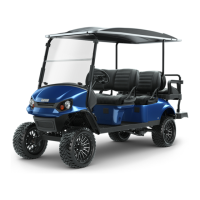Page 30
Owner’s Manual and Service Guide
VEHICLE WARRANTIES
BATTERY MAINTENANCE INSTRUCTIONS
WARNING! - ALWAYS WEAR A FACE SHIELD, RUBBER GLOVES AND PROTECTIVE CLOTHING WHEN
WORKING ON BATTERIES.
WATERING – PERIODICALLY CHECK THE LEVEL IN EVERY CELL AND FILL THE BATTERIES TO THE
CORRECT LEVEL AS REQUIRED (see picture below). As batteries age the frequency will increase. The use of a
battery-watering gun will assist in accurately completing this task. Water should be added, if needed, after the charging
cycle has been completed unless the tops of the plates are exposed. In that case, water should be added before charging.
Be sure that water suitable for watering batteries (colorless, odorless, tasteless and suitable for drinking), preferably distilled
water, is utilized. If you have any doubt as to the suitability of the water, have it tested and add an appropriate water line
filter, if required.
It is very important that all battery cells be maintained at a consistent level being especially careful not to overfill in order to
obtain good battery life and minimize corrosion to the electrical system and vehicle.
CLEANING – MONTHLY WASH THE BATTERY TOPS WITH A SOLUTION OF ¼ CUP (60 ml) BAKING SODA
TO 1 ½ GALLONS (6 liter) OF CLEAR WATER.
After watering, spray the tops and sides of the batteries, the battery wiring, and battery racks with the baking soda solution.
Let the solution stand for at least 5 minutes to allow the neutralizing action to take place.
Rinse the entire area with a low-pressure spray of clear water. Do not wash electrical components with a direct stream of
high-pressure water.
If any evidence of corrosion is visible (green powdered foam), spray again with baking soda and let the solution stand for at
least 5 minutes before rinsing; repeat until all corrosion is removed.
Deposits on battery tops must be removed because they are conductive and cause self-discharge of the battery. Scrub the
battery tops with a bristle brush soaked in the baking soda solution. Rinse with clear water.
Never wash batteries without
first
neutralizing the entire battery area with a baking soda solution.
In addition to good maintenance, battery life can be extended by proper fleet rotation and maintaining the recommended tire
inflation. We also suggest keeping maintenance records of all work performed.
CHARGING – DAILY RECHARGE THE BATTERIES AFTER USE. Golf car batteries should be charged between
rounds if possible. All chargers should be periodically inspected to insure proper operation.
Before charging batteries, inspect all terminals for frayed conductors and loose or damaged connectors. Inspect all terminals
to assure that they are both clean (corrosion free) and securely fastened to battery posts.
It is unlikely that a fully charged battery will freeze, except in the most extreme cold conditions.
In the “off season” batteries should be fully charged, disconnected from the charger and stored in an unheated covered area.
Check the batteries during the “off season” at (30 day) intervals, recharge and disconnect charger after charging. DO NOT
leave the charger connected to the vehicle during “off season” storage.
Cars equipped with PDS/ DCS feature MUST be stored with the
tow/maintenance/run switch in the “tow/maintenance”
position.

